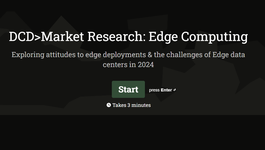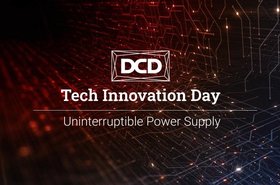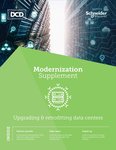For many people who now work out of home offices, the thought of redesigning a spare room into an effective, usable workspace can be daunting. Do I need to upgrade my bandwidth? That’s probably a common concern with the entire family now home (along with everyone else in your neighborhood), filling up your network pipeline with YouTube vids, online gaming, and streaming music. How do you remodel a space to minimize all these distractions and noise? Will your company pay for it? And so, you probably end up just limping along having Zoom meetings interrupted by weak network signals and barking dogs.
Similarly for data centers, while most professionals understand that significant efficiency gains can be made through data center modernization of infrastructure, delays in carrying out these projects are common. It can be a challenge to justify to senior management taking on tasks such as battery replacements or generator maintenance, replacing or updating aging infrastructure systems that are out of warranty, or migrating to next generation data center infrastructure management software. And so, many sadly limp along hoping nothing breaks or changes. That’s a risky business.
Data-backed tools to build your business case
Obviously, a sound business case that analyzes return on investment is needed. Estimating or quantifying the value of infrastructure modernization can be a challenge, for sure. Schneider Electric, however, has developed some free, easy-to-use tools to assist with doing that. Fundamentally, newer infrastructure systems are more energy efficient, tend to be smaller/lighter, are more reliable, faster to deploy and scale, simpler to manage and maintain, and tend to be friendlier to the environment. Calculating the value of these improvements (to YOUR business) is the trick to making an effective business case. And the value of each of these benefits is obviously influenced by your organization’s priorities and strategy.
Power and cooling systems from the early 2000s are not as energy efficient as new ones. By knowing a few simple variables, you can calculate energy savings that you can then use to help justify the expense of an upgrade. Our 3 Phase UPS Modernization OPEX Calculator, for example, can compare the costs of one Schneider Electric UPS vs. another over 10 years to see what the OpEx savings would be that covers energy use, spare parts, maintenance, and battery replacements. The savings can be used in your business case to offset the initial CapEx spend to get the new UPS. We also offer a Single Phase UPS Efficiency Calculator and Three Phase UPS Efficiency Calculator, which will illustrate the impact of UPS efficiency on energy cost and carbon footprint and can help make the business case for modernization. And for those in need of new UPS batteries, we recommend seriously considering a move from traditional valve-regulated, lead-acid systems to new lithium-ion batteries, which are lighter, smaller, and have a much longer lifespan. Our Li-ion vs. VRLA UPS Battery TCO Calculator can provide you with a sound estimation of the TCO cost savings.
Other keys to data center modernization
Vendors like Schneider Electric offer other modernization services besides selling new equipment at discounted prices. Many of the more modular infrastructure systems have serviceable or upgradeable components. This combined with extended warranties and service dispatch offers can, in effect, add life to an existing system while reducing the risk of unit failure or business interruption due to product age. When you’re developing a modernization plan and its business case, it’s important to understand what all your options are. White Paper 214, Guidance on What to Do with an Older UPS provides a framework to help you decide if you should upgrade components, replace with new, or do nothing and just let it rip. Although focused on data center UPSs, the same decision framework could be applied to other infrastructure systems as well.
Another thing to keep in mind as you build your business case is how much infrastructure you really need now and may need in the future. It’s quite possible the data center was overbuilt from a power and cooling capacity standpoint. Virtualization and consolidation may have shrunk your computing footprint over time. Some applications and services are likely in the cloud today or distributed in colocation data centers. Point is, your power and cooling requirements today may be much less than the capacity of the aging infrastructure installed now. So those savings should be part of the business case. You may not need to spend as much as you might’ve first assumed to upgrade to new equipment. Oh, and make sure you know your organization’s future IT outsourcing plans. That will obviously impact your future power and cooling infrastructure needs too! And don’t forget to include the value of having additional revenue-generating floor space if your infrastructure footprint is smaller. How could that floor space be put to better use and what value can you put on that? Be sure to account for it in your business case.
Perhaps one of the hardest things to account for in terms of financial impact is the cost of downtime. As the infrastructure ages, the risk of equipment failure goes up. How much a device failure risks causing a business disruption might be hard to know. It will depend on the details of your power and cooling design and how well that design has been managed and maintained over time. Regardless, it can be helpful to calculate what it would cost per minute or hour if certain IT apps or functions (powered and cooled by the infrastructure) go offline. If you can’t process payments for 30 minutes, what does that cost the business? If your factory automation stops in the middle of a shift, what does that cost you potentially? Sometimes these types of figures alone will convince upper management it’s not worth the risks of not modernizing.
Consider the modernization strategy for your business
Although only applicable to single phase UPSs 20kVA or less, our new TradeOff Tool, Edge UPS Fleet Management Comparison Calculator, might be helpful to give you a sense of how the risk and cost to own aging UPS assets increases. The calculator’s purpose is to help people figure whether they should manage their distributed fleet of UPSs themselves or let a third-party vendor do it for them. Costs are broken out for transportation and parts, staff, downtime, and vendor/partner services.
Whatever your business, there’s a lot to consider when you’re improving the lifetime of your IT and data center equipment. I hope this post helps you build the business case you need to modernize!
More from Schneider Electric (Life Is On)
-

-

Sponsored Assessing sustainability
-



